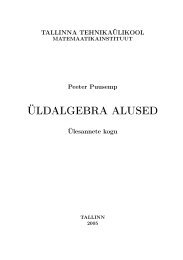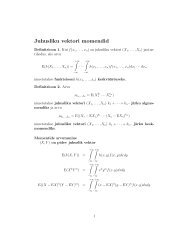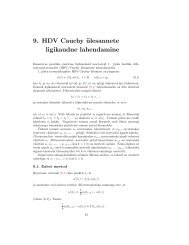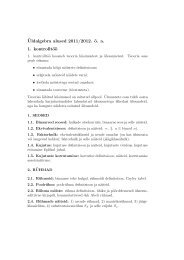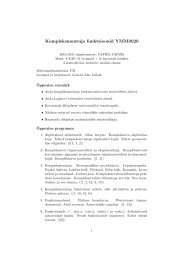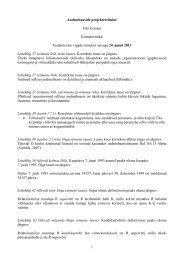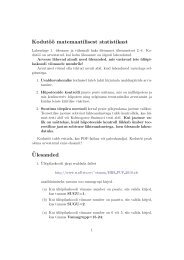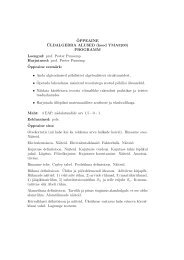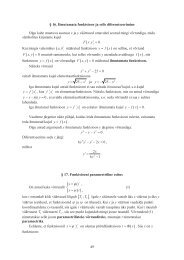SHANNON SAMPLING SERIES WITH AVERAGED KERNELS1 1 ...
SHANNON SAMPLING SERIES WITH AVERAGED KERNELS1 1 ...
SHANNON SAMPLING SERIES WITH AVERAGED KERNELS1 1 ...
You also want an ePaper? Increase the reach of your titles
YUMPU automatically turns print PDFs into web optimized ePapers that Google loves.
2 A.KIVUNUKK, G.TAMBERG<br />
In this paper we study an even band-limited kernel s, i.e. s ∈ B 1 π, defined by an even window function<br />
λ ∈ C [−1,1], λ(0) = 1, λ(u) = 0 (|u| 1) by the equality<br />
s(t) := s(λ; t) :=<br />
In fact, this kernel is the Fourier transform of λ ∈ L 1 (R),<br />
s(t) =<br />
1<br />
0<br />
λ(u) cos(πtu) du. (3)<br />
π<br />
2 λ∧ (πt). (4)<br />
These types of kernels arise in conjunction with window functions widely used in applications (e.g. [1], [2], [8],<br />
[16]), in Signal Analysis in particular. Many kernels can be defined by (3), e.g.<br />
1) λ(u) = 1 defines the sinc function;<br />
2) λ(u) = 1 − u defines the Fejér kernel sF (t) = 1 2 t<br />
2sinc 2 (cf. [19]);<br />
3) λj(u) := cos π(j + 1/2)u, j = 0, 1, 2, . . . defines the Rogosinski-type kernel (see [11]) in the form<br />
2 πu<br />
4) λH(u) := cos 2<br />
rj(t) := 1<br />
<br />
2<br />
sinc(t + j + 1<br />
1<br />
) + sinc(t − j −<br />
2 2 )<br />
<br />
= (−1)j<br />
π<br />
1 = 2 (1 + cos πu) defines the Hann kernel (see [13])<br />
(j + 1/2) cos πt<br />
(j + 1/2) 2 ; (5)<br />
− t2 sH(t) := 1 sinc t<br />
; (6)<br />
2 1 − t2 5) λB,a(u) := 1<br />
1<br />
2 + a cos πu + ( 2 − a) cos 3πu defines the Blackman-Harris kernel (a special case of the general<br />
cosine window, where: a0 = 1<br />
2 , a1 = a = 1<br />
2 − a3, a2 = 0, cf. [14], [15])<br />
sB,a(t) := (16a − 9)t2 + 9<br />
2(1 − t 2 )(9 − t 2 )<br />
sinc t = 1<br />
2<br />
3<br />
k=0<br />
ak<br />
<br />
<br />
sinc(t + k) + sinc(t − k) . (7)<br />
If a = 9/16 the latter has especially rapid decrease at infinity – s B,9/16(t) = O(|t| −5 ) as |t| → ∞.<br />
First we used the band-limited kernel in general form (3) in [10], see also [5].<br />
Now we will study the sampling operators (1) using averaged kernels of the kernel functions (3), i.e.<br />
sm(t) := 1<br />
m<br />
m/2 <br />
−m/2<br />
s(t + v) dv (m > 0), (8)<br />
which is suitable for functions of bounded variation. To give concrete examples we restrict ourselves to Blackman-<br />
Harris kernels, because they are rapidly decreasing at infinity and the Blackman-Harris operators have norms,<br />
which are very close to one.<br />
We say that the sampling operator SW : T V (R) → T V (R) has the variation detracting property for functions<br />
f ∈ T V (R) of bounded variation (cf. [4] and references cited therein), if<br />
VR[SW f] SW VR[f]. (9)<br />
As an introductory approach we use averaged kernels to get for these operators the variation detracting property.<br />
2. Preliminary results<br />
The most general kernel for the sampling operators (1) is defined in the following way.



